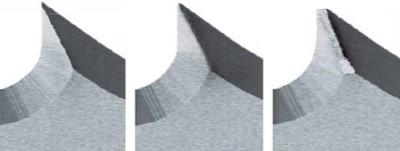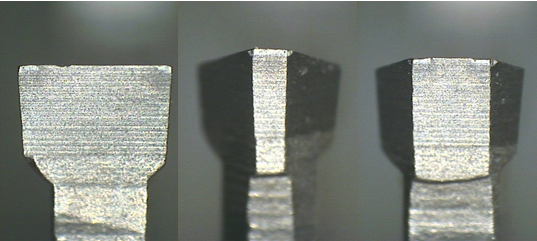North American Sales Manager, Saws and Hand Tools
- FMA
- The Fabricator
- FABTECH
- Canadian Metalworking
Categories
- Additive Manufacturing
- Aluminum Welding
- Arc Welding
- Assembly and Joining
- Automation and Robotics
- Bending and Forming
- Consumables
- Cutting and Weld Prep
- Electric Vehicles
- En Español
- Finishing
- Hydroforming
- Laser Cutting
- Laser Welding
- Machining
- Manufacturing Software
- Materials Handling
- Metals/Materials
- Oxyfuel Cutting
- Plasma Cutting
- Power Tools
- Punching and Other Holemaking
- Roll Forming
- Safety
- Sawing
- Shearing
- Shop Management
- Testing and Measuring
- Tube and Pipe Fabrication
- Tube and Pipe Production
- Waterjet Cutting
Industry Directory
Webcasts
Podcasts
FAB 40
Advertise
Subscribe
Account Login
Search
Breaking in a band saw blade contributes to service life, cut quality
Proper conditioning at the outset gets the most mileage from a new band saw blade
- By Jay Gordon
- February 22, 2022
- Article
- Sawing

A new blade has a razor-sharp tooth, the tip of which is delicate (left). When broken in properly, it has a small radius (center). If used without a break-in period, the cutting edge is likely to become chipped and jagged (right).
In today’s competitive environment, everyone is on the lookout for ways make their business operations more profitable. Sometimes, cutting costs can seem like an attractive way to do so. However, simply reducing the cost of equipment or a process is not a guarantee of success. A better goal is to become more efficient on the job so that manufacturing operations are more productive, ultimately improving the bottom line.
In the context of band saw cutting operations, an important way to increase productivity is to extend the blade’s service life. Fabrication and metalworking shops are always looking for a band saw blade that will last longer and deliver better-quality cuts. And while cost per blade is important—and very easy to measure—it is the cost per cut that really matters. Using a band saw blade that lasts longer minimizes the cost per cut and correlates directly to productivity.
The service life of a band saw blade and the quality of the surface finish at the cut end are not determined solely by the blade manufacturer’s product design. Machine maintenance and operating practices can contribute to, or detract from, this performance. Assuming that the band saw is well-maintained and that the operator follows the speed and feed settings recommended by the manufacturer, one more critical, often overlooked, step remains: breaking in the blade.
Virtually all manufacturers agree a blade that has been broken-in properly has a service life that is substantially longer than one that hasn’t. So why would the operator skip this important step? Some feel it is not worthwhile because it comes at the short-term cost of reducing the feed pressure for the first 25 to 100 sq. in. of cutting. These operators don’t factor in the long-term benefit, which is an extended lifespan with less-frequent blade changes and, therefore, more uptime. A proper break-in period also improves the surface finish of the cuts.
Breaking Down the Break-in Process
What does breaking-in a blade actually do? New band saw blades have very sharp edges on the teeth that can break off easily if the blade isn’t properly conditioned. This is similar to a freshly sharpened pencil: The sharp point can break off, leaving an irregular, jagged point that doesn’t write well. Starting with just a little pressure, then increasing the pressure gradually, hones the point of the pencil or leading edge of the blade tooth to a very fine radius. On the saw blade, this radius allows the chip to shear away from the workpiece more readily, and also gives the required support to the tooth tip, which undergoes extreme forces in the cutting process.After the teeth are honed and properly broken in, the blade will cut faster, straighter, and longer than a blade that was broken in incorrectly or not at all.
Breaking in The Blade, Raking in the Productivity
The process for breaking in a band saw blade varies from application to application and depends on the characteristics of the material being cut. The primary consideration is that the break-in speed is the same as the normal running speed, which most manufacturers specify as surface feet per minute (SFPM).For softer materials, such as carbon steel and aluminum, common practice calls for reducing the feed pressure to 50% of the normal cutting feed pressure for the first 50 to 100 sq. in. The transition to the full cutting speed should be gradual.
For harder materials such as nickel-based alloys, as well as other difficult-to-cut materials including hardened steels, tool steels, and stainless steels, the break-in practice usually isn’t as rigorous. A feed pressure of 75% of the normal pressure over the first 25 to 75 sq. in. is sufficient. The increase in feed pressure should take place gradually, reaching 100% after 50 sq. in.
The saw operator should take care when increasing the feed pressure, as doing so too quickly can lead to vibrations that disturb the cutting process.
About the Author
About the Publication
Related Companies
subscribe now

The Tube and Pipe Journal became the first magazine dedicated to serving the metal tube and pipe industry in 1990. Today, it remains the only North American publication devoted to this industry, and it has become the most trusted source of information for tube and pipe professionals.
start your free subscription- Stay connected from anywhere

Easily access valuable industry resources now with full access to the digital edition of The Fabricator.

Easily access valuable industry resources now with full access to the digital edition of The Welder.

Easily access valuable industry resources now with full access to the digital edition of The Tube and Pipe Journal.
- Podcasting
- Podcast:
- The Fabricator Podcast
- Published:
- 04/16/2024
- Running Time:
- 63:29
In this episode of The Fabricator Podcast, Caleb Chamberlain, co-founder and CEO of OSH Cut, discusses his company’s...
- Trending Articles
Zekelman Industries to invest $120 million in Arkansas expansion

3D laser tube cutting system available in 3, 4, or 5 kW

Corrosion-inhibiting coating can be peeled off after use

Brushless copper tubing cutter adjusts to ODs up to 2-1/8 in.

HGG Profiling Equipment names area sales manager

- Industry Events
16th Annual Safety Conference
- April 30 - May 1, 2024
- Elgin,
Pipe and Tube Conference
- May 21 - 22, 2024
- Omaha, NE
World-Class Roll Forming Workshop
- June 5 - 6, 2024
- Louisville, KY
Advanced Laser Application Workshop
- June 25 - 27, 2024
- Novi, MI



























